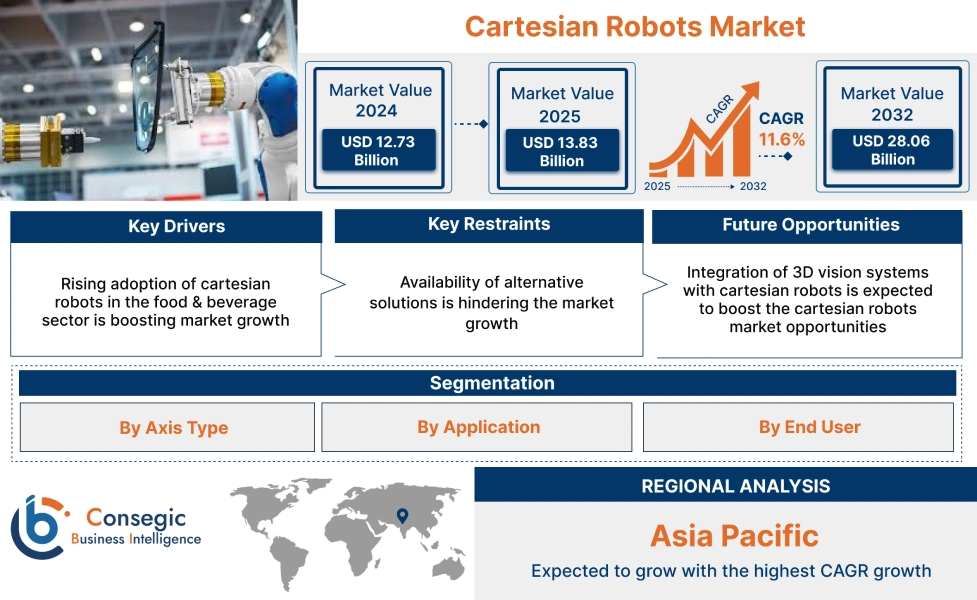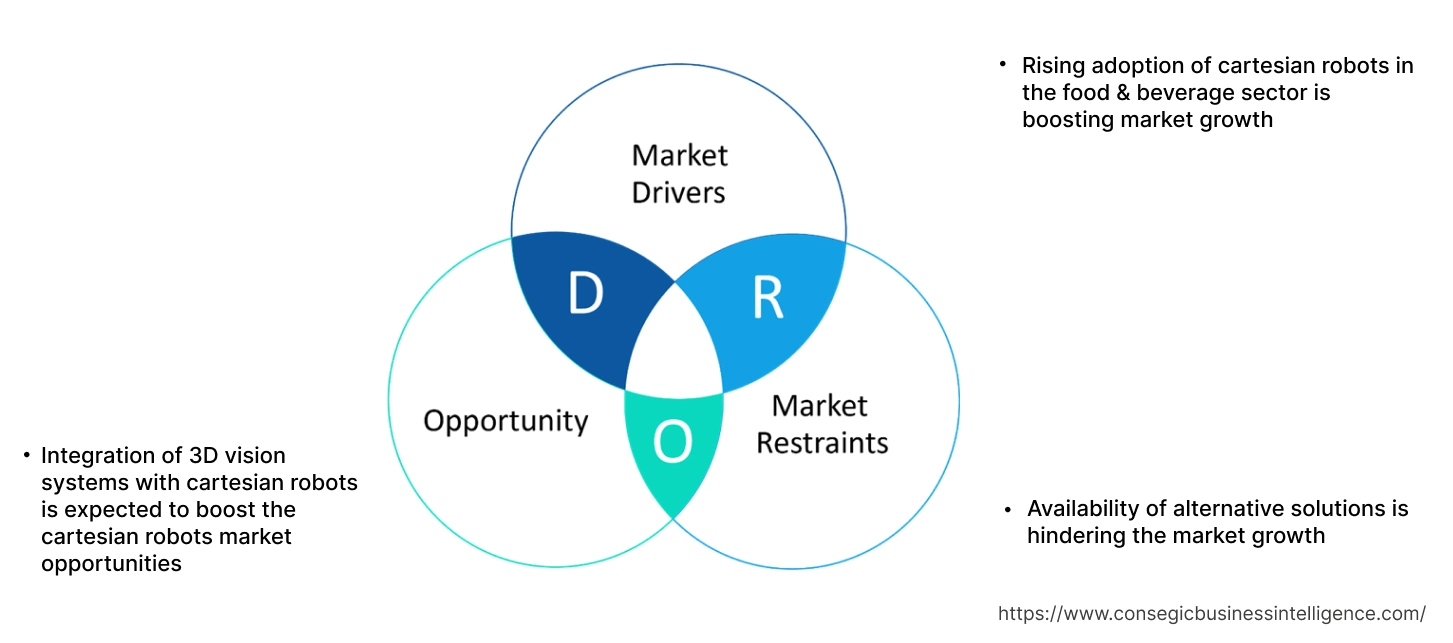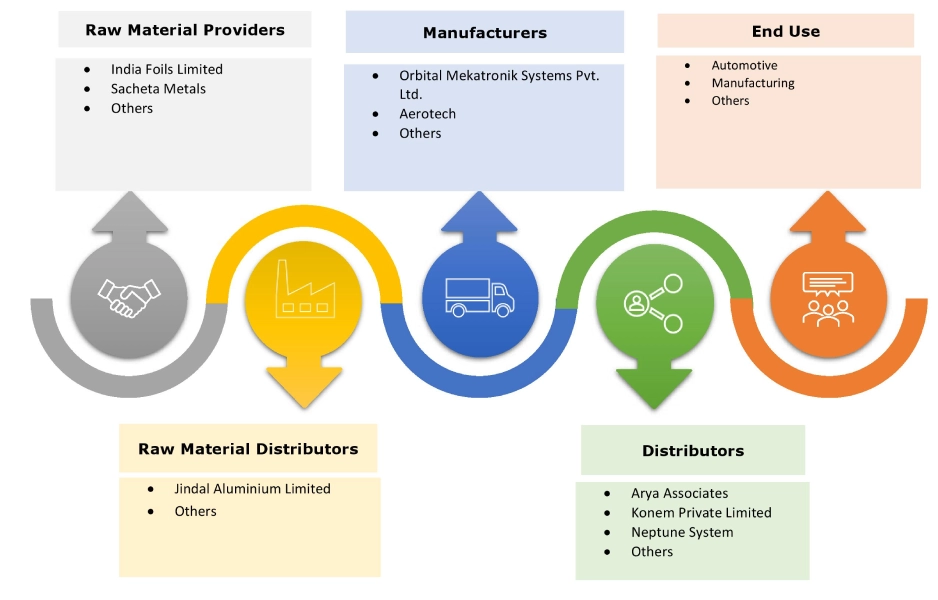Cartesian Robots Market Size:
Cartesian Robots Market size is estimated to reach over USD 28.06 Billion by 2032 from a value of USD 12.73 Billion in 2024 and is projected to grow by USD 13.83 Billion in 2025, growing at a CAGR of 11.6% from 2025 to 2032.
Cartesian Robots Market Scope & Overview:
Cartesian robots, also known as linear or gantry robots, are industrial robots that move along three linear axes (X, Y, and Z). They are characterized by their straight-line movements and are used in tasks including material handling, assembly, and packaging. These robots are used for picking up and placing parts or components in assembly lines, packaging, and other applications requiring precise movements. Gantry robots are employed for transporting raw materials or finished products between different areas of a manufacturing facility.
Cartesian Robots Market Dynamics - (DRO) :
Key Drivers:
Rising adoption of cartesian robots in the food & beverage sector is boosting market growth
Cartesian robots automate the loading and unloading of trays, boxes, and pallets on conveyor belts. They are used for picking, placing, sorting, and applying labels to food and beverage products. In food & beverage facilities, gantry robots are used for automated dispensing systems. They assist with tasks such as moving ingredients, transferring products, and cleaning. Gantry robots handle heavier payloads and are used for palletizing and material handling. They can perform inspections and quality checks on products during the production process. In restaurants, robots automate tasks like serving food, bussing tables, and cleaning among others.
- For instance, Shibaura Machine offers cartesian systems for packaging and manufacturing in the food and beverages sector. The products are available in Cartesian Coordinate Robot COMPO ARM BA-Ⅲ
Thus, the aforementioned factors are boosting the adoption of gantry robots, in turn driving the cartesian robots market growth.
Key Restraints:
Availability of alternative solutions is hindering the market growth
Several alternatives are available for cartesian robots including articulated arms, SCARA robots, and others. Articulated arms offer several benefits due to their versatility and adaptability, making them suitable for a wide range of applications. They excel in tasks requiring precision, complex movements, and access to difficult-to-reach areas, particularly in manufacturing, healthcare, and aerospace.
Moreover, SCARA robots are typically used for pick-and-place tasks in assembly lines, and they can perform rotations. Thus, the market analysis shows that the aforementioned factors are restraining the cartesian robots market demand.
Future Opportunities :
Integration of 3D vision systems with cartesian robots is expected to boost the cartesian robots market opportunities
Integrating 3D vision systems with cartesian robots enhances the capabilities of these robots, allowing precise object detection, quality inspection, and adaptive handling of complex tasks. 3D vision systems provide depth perception, allowing robots to accurately identify and locate objects in 3D space, leading to more precise movements and placement. Vision systems detect and identify objects, even with imperfections or variations in color or shape, making them ideal for tasks like sorting and quality control.
- For instance, Keyence offers 3D vision systems for industrial robots including Cartesian robots. The advanced vision systems offer increased efficiency and productivity.
Thus, the ongoing advancements in gantry robots are projected to drive cartesian robot market opportunities during the forecast period.
Cartesian Robots Market Segmental Analysis :
By Axis Type:
Based on the axis type, the market is segmented into 1-axis, 2-axis, 3-axis, and 4-axis.
Trends in the Axis Type:
- Rising adoption of 4-axis gantry robots to offer a combination of speed, precision, and adaptability is boosting the market growth.
- Increasing trend in adoption of 2-axis gantry robots, due to ease of programming, cost-effectiveness, and adaptability to various tasks.
The 3-axis segment accounted for the largest revenue share in the market in 2024, and it is expected to register the fastest CAGR growth during the forecast period.
- 3-axis cartesian robots are industrial robots that move along three linear axes (X, Y, and Z) to perform various tasks.
- They are commonly used in applications including assembly, material handling, packaging, and precision manufacturing.
- These robots excel at placing components accurately and consistently, improving product quality and efficiency.
- Moreover, they are ideal for picking and placing, loading/unloading, and transporting materials, in turn reducing manual labor.
- For instance, Oriental Motor USA Corp. offers an OVR series cartesian 3-axis robot. The robot comes in frame mounting installation type and L-type combination direction.
- Therefore, the market trends depict that the widespread adoption of 3-axis gantry robots is boosting the cartesian robots market trends.
By Application:
Based on the application, the market is segmented into handling, palletizing, welding, and others.
Trends in the Application:
- Rising demand for gantry robots for welding applications due to their increased accuracy, consistency, and safety is boosting the market growth.
- Increasing trend in the adoption of gantry robots due to their high precision, repeatability, and ability to handle heavy loads is driving the cartesian robots market size.
The handling segment accounted for the largest revenue share in the cartesian robots market share in 2024.
- Cartesian robots are well suited for material handling tasks requiring precision and accuracy.
- Gantry robots achieve high positioning accuracy which is crucial for tasks involving delicate components or where consistent placement is crucial.
- These robots are customized to handle light to heavy loads and can be scaled up or down to fit the application.
- Their rigid structure and solid construction make them reliable and resistant to vibrations and deflections.
- Therefore, the market analysis shows that the aforementioned factors are boosting the cartesian robots market growth.
The palletizing segment is expected to register the fastest CAGR during the forecast period.
- Cartesian palletizers efficiently move products across several axes to stack them on pallets at a fast pace, improving overall process efficiency.
- By automating palletizing tasks, businesses can significantly reduce their reliance on manual labor, freeing up human workers for more complex tasks.
- Robotic palletizers consistently position products on pallets with precision, reducing damage during shipping and transportation.
- Robotic palletizers operate continuously and handle repetitive tasks with precision and speed, leading to a substantial boost in output.
- Thus, the market analysis states that the rising demand for gantry robots for palletizing applications is expected to boost the cartesian robots market trends during the forecast period.
By End User:
Based on the end user, the market is segmented into automotive, electrical & electronics, food & beverages, pharmaceuticals, manufacturing, and others.
Trends in the End User:
- Rising adoption of gantry robots in the pharmaceutical sector for placing pills, vials, and other pharmaceutical products into blister packs, boxes, and other secondary packaging.
- Increasing demand for gantry robots in the electrical & electronics sector for tasks requiring precise placement and handling, including PCB assembly, component placement, and 3D printing is boosting the cartesian robots market size.
The automotive segment accounted for the largest revenue share of 39.75% in the cartesian robots market share in 2024.
- Cartesian robots are used for loading and unloading parts in injection molding machines, as well as for assembling components including seat buttons and gas pedal mechanisms.
- They are employed for tasks including picking and placing parts, particularly in automotive assembly lines for smaller components.
- Cartesian robots can range from small, compact systems to large, multi-axis platforms, making them adaptable to various applications in automotive facilities.
- They are customized to fit specific needs, with options for different actuators, motors, and control systems.
- Therefore, the market analysis depicts that the aforementioned factors are boosting the cartesian robots market demand.
The manufacturing segment is expected to register the fastest CAGR during the forecast period.
- Cartesian robots automate tasks including component assembly, fastening screws, and glue dispensing, offering speed, accuracy, and repeatability.
- They are used in manufacturing facilities for handling and moving parts, materials, or tools between different locations on an assembly line or within a manufacturing cell.
- Gantry robots transfer materials between machines, load and unload machine tools, and manage inventory within a manufacturing facility.
- They are incorporated into CNC machines for tasks like drilling, cutting, milling, and laser cutting, providing precise control over tool movements.
- Thus, the market analysis depicts that the aforementioned factors are expected to boost the cartesian robots market expansion during the forecast period.
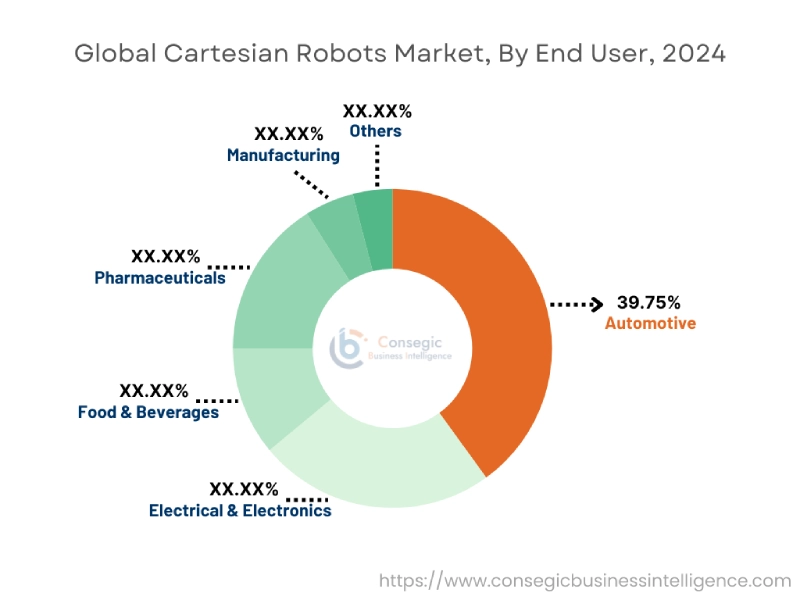
Regional Analysis:
The regions covered are North America, Europe, Asia Pacific, the Middle East and Africa, and Latin America.
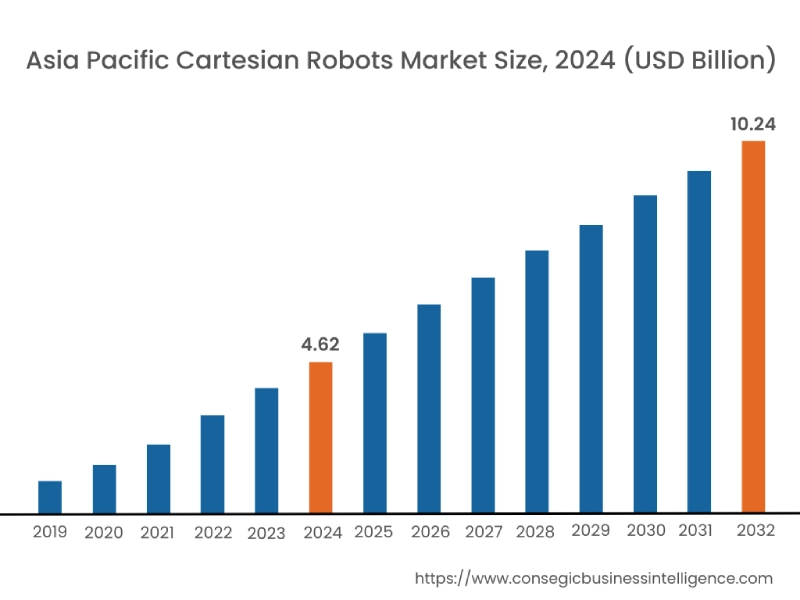
Asia Pacific region was valued at USD 4.62 Billion in 2024. Moreover, it is projected to grow by USD 5.02 Billion in 2025 and reach over USD 10.24 Billion by 2032. Out of this, China accounted for the maximum revenue share of 39.98%. The cartesian robots market analysis shows that the market is driven by the growing automotive industry, enhanced safety features, research and development, and globalization. Moreover, rapid industrialization in Asian countries is increasing the need for automation in manufacturing processes, making gantry robots a popular choice.
- For instance, according to the International Organization of Motor Vehicle Manufacturers (OICA), China was the biggest producer of automobiles across the globe in 2023, with total vehicle production reaching 30,160,966 units. This leads to the adoption of cartesian robots in handling, palletizing, welding, and several other applications during automotive manufacturing. Thus, the aforementioned factors are driving the cartesian robots market expansion in the region.
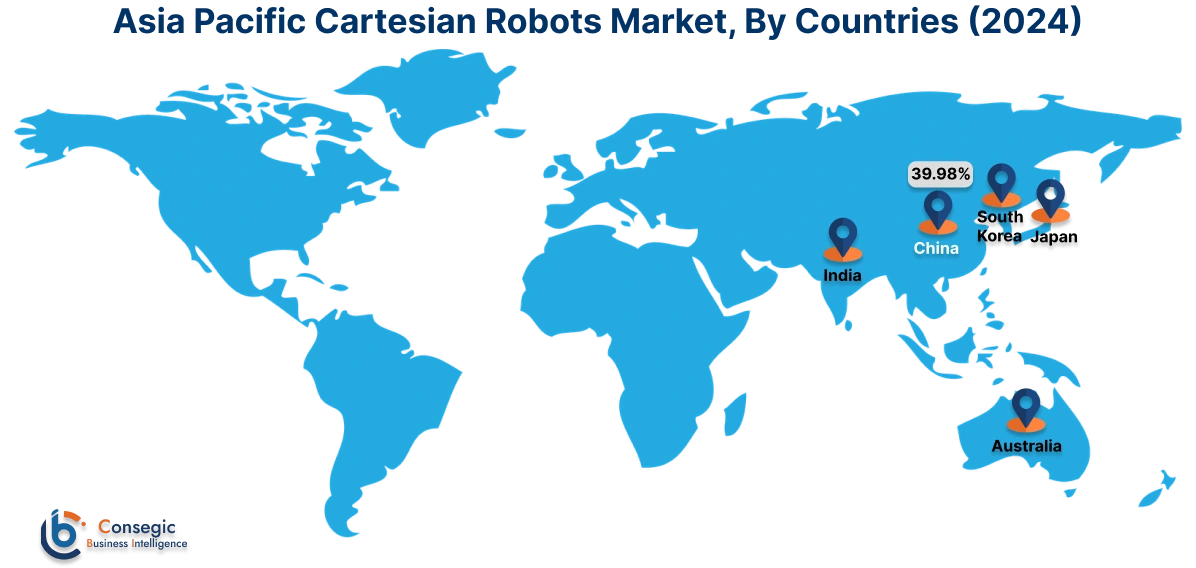
North America is estimated to reach over USD 8.45 Billion by 2032 from a value of USD 3.72 Billion in 2024 and is projected to grow by USD 4.05 Billion in 2025. The cartesian robots market analysis shows that the market is primarily driven due to increasing automation in industries including manufacturing, healthcare, food & beverage, and others.
In Europe, the market is driven by the need for automation in the industrial sector, advancements in robotics technology, and the adoption of new technologies by manufacturers. In Latin America, the Middle East, and Africa, the market is primarily driven by the adoption of gantry robots in industries including manufacturing, healthcare, and education among others.
Top Key Players and Market Share Insights:
The cartesian robots industry is highly competitive with major players providing solutions and services to the national and international markets. Key players are adopting several strategies in research and development (R&D), product innovation, and end-user launches to hold a strong position in the global cartesian robots market. Key players in the cartesian robots industry include -
- Güdel Group AG (Germany)
- Aerotech (US)
- Denso Corporation (Japan)
- IAI America, Inc. (US)
- Orbital Mekatronik Systems Pvt. Ltd. (India)
- Bosch Rexroth AG (Germany)
- ABB (Switzerland)
- Toshiba Machine Co., Ltd. (Japan)
- YRG Inc. (US)
- STON Robot Changzhou Co., Ltd. (China)
Recent Industry Developments :
Product Launches:
- In November 2024, Oriental Motor launched OVR Series industrial robots. The new cartesian robot is a 3-axis model, which is controlled
Cartesian Robots Market Report Insights :
| Report Attributes | Report Details |
| Study Timeline | 2019-2032 |
| Market Size in 2032 | USD 28.06 Billion |
| CAGR (2025-2032) | 11.6% |
| By Axis Type |
|
| By Application |
|
| By End User |
|
| By Region |
|
| Key Players |
|
| North America | U.S. Canada Mexico |
| Europe | U.K. Germany France Spain Italy Russia Benelux Rest of Europe |
| APAC | China South Korea Japan India Australia ASEAN Rest of Asia-Pacific |
| Middle East and Africa | GCC Turkey South Africa Rest of MEA |
| LATAM | Brazil Argentina Chile Rest of LATAM |
| Report Coverage |
|
Key Questions Answered in the Report
How big is the cartesian robots market? +
Cartesian Robots Market size is estimated to reach over USD 28.06 Billion by 2032 from a value of USD 12.73 Billion in 2024 and is projected to grow by USD 13.83 Billion in 2025, growing at a CAGR of 11.6% from 2025 to 2032.
What are the major segments covered in the cartesian robots market report? +
The segments covered in the report are axis type, application, end user, and region.
Which region holds the largest revenue share in 2024 in the cartesian robots market? +
Asia Pacific holds the largest revenue share in the cartesian robots market in 2024.
Who are the major key players in the cartesian robots market? +
The major key players in the market are Güdel Group AG (Germany), Aerotech (US), Bosch Rexroth AG (Germany), ABB (Switzerland), Toshiba Machine Co., Ltd. (Japan), YRG Inc. (US), STON Robot Changzhou Co., Ltd. (China), Denso Corporation (Japan), IAI America, Inc. (US), Orbital Mekatronik Systems Pvt. Ltd. (India), and others.
